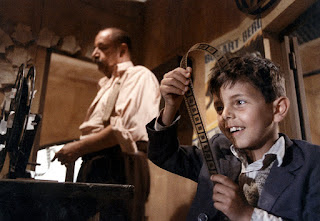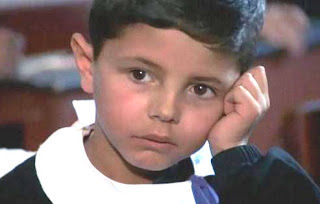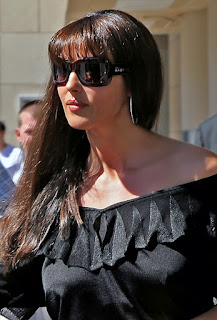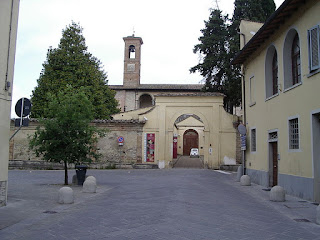Child star of classic movie Cinema Paradiso
The actor Salvatore Cascio, who earned fame through his starring role in the Oscar-winning movie Cinema Paradiso, was born on this day in 1979 in Palazzo Adriano, a small town in a mountainous area of western Sicily.
Cascio (right) in a famous scene from Cinema
Paradiso alongside Philippe Noiret's Alfredo
In Guiseppe Tornatore’s nostalgic 1988 drama, Cascio was the eight-year-old child chosen to play the part of the the film’s central character as a small boy in a Sicilian village who loves to watch films at his local cinema and develops a friendship with the cinema’s grumpy but good-hearted projectionist, Alfredo.
His performance was so charming and captivating it won him the prize for best actor in a supporting role at the 1990 BAFTAs. He remains the only Italian to have won such an award. Roberto Benigni, star and director of the 1997 film Life is Beautiful, is the only Italian to have won a BAFTA as best actor.
By coincidence, the lead character in Cinema Paradiso is also called Salvatore and, like Cascio, is known as a boy as Totò, the Sicilian diminutive of Salvatore.
Landing the part was not down to just having the same name, however, although it helped when it came to filming.
 |
| Cascio was chosen for the part of his namesake Totò from more than 200 hopeful boys |
Location shooting for Cinema Paradiso - or Nuovo Cinema Paradiso as it was called in Italian cinemas - took place almost entirely in Sicily, with several scenes shot in Tornatore’s home town of Bagheria, near Palermo.
The principal location was Palazzo Adriano, where the central Piazza Umberto I was chosen as the main square of Giancaldo, the fictional town where the Cinema Paradiso picture house was located. The cinema’s facade was built on the square and some of the interior scenes were constructed in the nearby church of Maria Santissima del Carmelo.
Tornatore’s crew remained in Palazzo Adriano for three months. Cascio recalled that the days were long and tiring, often starting at 7am and going on until late in the evening, with some scenes requiring 20 or more takes before the director was satisfied.
.jpeg) |
| As an adult, Cascio chose a different life, running a restaurant with his father |
Cascio found himself in demand after his success with Cinema Paradiso and found himself playing opposite some major stars in films such as Breath of Life, with Vanessa Redgrave, Franco Nero, and Fernando Rey; C’era un castello con 40 cani (There Was a Castle with 40 Dogs) with Peter Ustinov; Stanno tutti bene (Everybody’s Fine), with Marcello Mastroianni; and Jackpot with Christopher Lee and Adriano Celentano.
He also appeared in a number of TV dramas yet by the end of the 1990s his life was moving in a different direction. A star almost by accident, having never really had ambitions to make a career in acting, he decided ultimately that the life that beckoned was not for him.
Instead, he went into partnership with his father in opening a restaurant with rooms. They found a property in Chiusa Sclafani, a village not far from Palazzo Adriano, and called it L’Oscar dei Sapori - the Oscar for Flavours.
The restaurant is themed with Cinema Paradiso memorabilia and Cascio remains willing to talk about the film that played such a huge part in his life, even though it is now 34 years since it was made. He is often invited to movie events.
Earlier this year, he published his autobiography, entitled La gloria e la prova - The Glory and the Test - written with the help of journalist Giorgio De Martino, in which he enthuses about the glory of the cinema and also talks about the challenges he has faced since being diagnosed, in his early thirties, with retinitis pigmentosa, a progressive, hereditary disease that will ultimately deprive him of much of his peripheral vision.
Travel tip:
Piazza Umberto I in the Sicilian town of Palazzo
Adriano featured prominently in Cinema Paradiso
Palazzo Adriano, where Cascio was born and grew up and which forms the backdrop to many scenes in Cinema Paradiso, is an inland town situated on the slopes of Monte delle Rose in western Sicily, almost equidistant between Palermo, on the northern coast of the island, and Agrigento, on the southern coast. A settlement has existed at the site since at least the 11th century, Between the 15th and 19th centuries, the area was populated by a large community of Albanians, speaking a version of the Albanian language known as Arberesh. Just off the central Piazza Umberto I is a small museum dedicated to the film, Cinema Paradiso. The town also has the remains of a Bourbon castle. As well as Cascio, Palazzo Adriano also claims to be the birthplace of Francesco Crispi, the first Sicilian to be Italy’s prime minister and one of the major protagonists of Italian unification, along with his friends Giuseppe Mazzini and Giuseppe Garibaldi.
Travel tip:.jpg)
Bagheria is famous for its wealth of Baroque
villas, such as the Villa Palagonia
Bagheria, the birthplace of Cinema Paradiso’s director, Giuseppe Tornatore, can be found 15km (9 miles) southeast of Palermo, occupying an elevated position a short distance from the sea. A traditional Sicilian town that descends towards the fishing village of Aspra, in the 17th and 18th centuries it was a favoured by the aristocracy of Palermo as somewhere to spend the summer months, the legacy of which is some 20 or more Baroque villas that add to the town’s charm. Tornatore employed locations in the town both in Cinema Paradiso and his 2009 film Baarìa - which is its Sicilian dialect name - which told the history of the town from the 1930s to the 1980s through the life of a local family. Parts of The Godfather Part III were also shot in Bagheria.
Also on this day:
1830: The death of Francis I of the Two Sicilies
1931: The birth of film director Paolo Taviani
1936: The birth of actress Virna Lisi
1942: The birth of footballer Sandro Mazzola
1982: The birth of golfer Francesco Molinari










